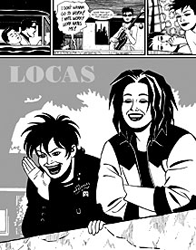Crazy For Each Other
The longest-running story arc of a master comics creator, compiled at last

Locas: The Maggie and Hopey Stories
Written and illustrated by Jaime Hernandez
Fantagraphics, $49.95
It’s easy to like Jaime Hernandez’s comics for the wrong reasons. He and his brother Gilbert (also a gifted cartoonist with a very different style) started publishing their work together in the Love and Rockets series in 1981, and it was an instant hit—Hernandez’s black-and-white drawing is eye candy, his dialogue is perky and witty, and basically everyone who went to indie-rock shows in the 1980s has read his work in small doses: “Oh, right, the Maggie and Hopey stories. I always really liked those, a friend of mine has a cat named Hopey.” In their archetypal forms, Maggie’s a curvy Mexican-American mechanic and Hopey’s her skinny, punky, attitudinal best friend, roommate and sometimes lover. From their reputation, you’d think Hernandez’s comics were an edgier version of Laverne & Shirley.
They’re nothing of the kind. All the Maggie-and-Hopey stories from 1981 to 1996 have been collected in a single, wonderful 700-page hardcover, Locas, and taken together, they become something much richer and darker. For one thing, they flow into a fantastically intricate narrative about dozens of friends and relations, covering two decades. (Hernandez is a master of using a few perfectly assured lines to show how bodies and faces, and even body language, change over time.) His characters all have pasts and perceptions and inner lives, even if we don’t know about them for years; they grow and change, on-panel or off, sometimes radically. Chepa, the gray-haired, bespectacled mom who turns up late in the book, is just barely recognizable as the ferocious gang member who’d appeared in the background a few times ten years earlier.
In addition, although almost all of these stories have to do with Maggie and Hopey’s friendship in one way or another, the two of them are hardly ever together. They’re only actually roommates briefly; lots of people gossip for the first few hundred pages about whether or not they’re a couple, but on the same page where we see for the first time that they are lovers, we find out that Hopey’s sleeping with her band’s guitarist too. Immediately after that, Maggie and Hopey are separated–thanks to a small, off-panel betrayal whose significance is only clear later on–and barely see each other for the rest of the book. Clearly, this is not your usual “relationship” comic.
The first quarter or so of Locas was originally published before Hernandez found his voice as a cartoonist. It’s still pretty great (especially 1983’s “100 Rooms,” which appears here in its later expanded version), but it’s very different from the rest. Maggie is unequivocally the star of the early stories, a tough, cute mechanic who goes on crazy adventures involving giant lizards and killer robots; the glamorous science-fiction life isn’t her world, but she sort of wants to be part of it. Occasionally, there are short stories that are just about Maggie and the group of friends she sends letters home to, especially Hopey–oddly, the non-sci-fi stories are drawn more cartoonishly, with less shading and “realistic” detail, but Hernandez’s heart seems to be more in them.
And then, on page 178, Hernandez reveals the full names of the six women he’s been telling us about, and everything abruptly falls into place.
Wanna finish reading this essay? Visit our website at www.ruminator.com to find out where you can pick up a copy of Ruminator in your neighborhood!